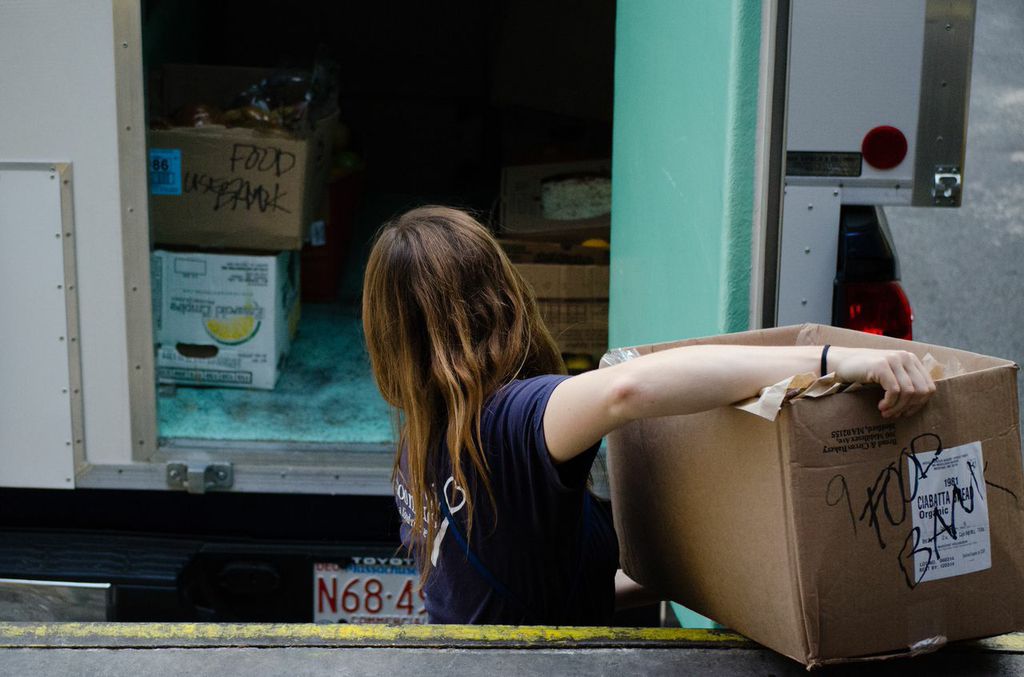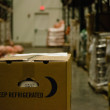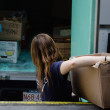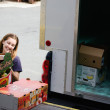In 2011, the Environmental Protection Agency reported that America generated 36 million tons of food waste and 96 percent of that food went directly to landfills or incinerators.
In the same year, the EPA also reported that 14.9 percent of homes in the US did not know where their next meal would come from. Instead of ending up in landfills food can be composted or used to create energy, but if food is still usable, it can go to providing a meal for those who need it.
Across the United States, the Environmental Protection Agency (EPA) is leading a push to reallocate the food Americans throw away. In Massachusetts, reducing food waste is part of a statewide goal to decrease the burden put on landfills. The Office of Energy and Environmental Affairs reports that organics, like food waste, make up 25 percent of the current waste stream.
According to John Fischer, the branch chief for commercial waste reduction at the Massachusetts Department of Environmental Protection (MassDEP), in order to decrease the amount of food waste going into landfills, the state needs to develop an infrastructure for diversion. Fischer said that increasing the business interest in food waste diversion was a process years in the making.
In October, Massachusetts will begin enforcing a law banning food waste greater than one ton. An estimated 1,700 institutions, including hospitals, food processors and large college campuses will have to find ways to route this waste away from landfills, where space is already limited.
The ban part of a larger incentive to decrease the amount of waste going into Massachusetts landfills, which will increase the lifespan of the landfills that that already exist and prevent the state from having to build new ones. Gov. Deval Patrick’s administration has a goal of reducing the waste stream by 30 percent by 2020 and by 80 percent by 2050.
Patrick’s office and MassDEP finalized the details of the plan in January. Fischer said the food waste ban was first proposed in 2010 by the Organics Subcommittee within MassDEP.
“A lot of the earlier projects were developed with the knowledge that there would be something like a ban down the line,” Fischer said. “The ban is really intended to drive a consistent feedstock supply to encourage companies interested investment to build facilities in Massachusetts.”
There are three main avenues for diverting food: if the food is still usable, it can be redistributed to pantries or kitchens. Composting is another option. For large-scale operations this is usually done at large processing facilities. The state plan wants to use every option, but all of the funding attached to the bill is going to the development of the third avenue for diversion: anaerobic digestion, a process that converts organic waste into energy.
Investment in Digesting
When the food waste ban was announced in January, the governor’s office dedicated an additional $1 million to the development of the anaerobic digestion industry. According to Fischer, this is on top of about $3 million in loans offered to these facilities by the state.
This money is mainly for facilities that want to build digesters, but at the Deer Island Sewage Treatment Plant, digesters have already been used to convert solid waste from flushed-in sewage into useable energy.
Ria Convey, communications director of the Massachusetts Water Resources Authority (MWRA), compares the process to how humans digest food in their stomachs.
“Solids are digested in your stomach,” Convey said. “The good bacteria eats the bad bacteria and what’s left is methane gas.”
The methane provides heat, hot water and electricity to the plant. In addition to methane, the digestion process also produces fertilizer.
The state hopes that Deer Island can start processing more than just the area’s sewage. They’re testing a new program that would allow the island to process organic food waste from Boston using their digesters.
The facility received two grants from MassDEP for $100,000 and one from the Massachusetts Clean Energy Center up to $200,000 in order to install better storage and piping. The food waste is barged out to the island from Charleston by waste management, according to Convey.
Deer Island takes an average of 246 dry tons of sludge into the digesters per day. According to Convey, with the plan to introduce food waste, the sludge would increase by 50 to 60 dry tons per day.
At the other end of the process, the amount of dry tons they send to the fertilizer plant as pellets after processing would increase by an estimated six to eight dry tons per day.
The increase in the amount of sludge would also mean more methane. The methane produced using just sewage already covers most of the electrical demands of the plant. According to Covey, it saves them close to $15 million per year in electricity.
If the program is successful, the increased production of methane could mean Deer Island is one step closer to energy independence.
Donating as a First Line of Defense
In addition to the development of anaerobic digestion facilities, the government is also trying to build partnerships with organizations that use diverted food to feed people.
Lovin Spoonfuls, a nonprofit food recovery organization, was founded in January 2010 with the goal of transporting food that would be thrown away at grocery stores, small farms and farmers markets to the places and people who can use it, all while it’s still good to eat.
Lovin Spoonfuls uses a fleet of trucks and licensed drivers to take some 25,000 pounds of food every week from one partner location to another, like a food pantry or kitchen for preparation or distribution. Lauren Palumbo, chief operating officer at Lovin Spoonfuls, said the organization was always looking to increase their number of partnerships, but they are restricted by size and type of food.
For example, Palumbo said that Lovin Spoonfuls likely won’t receive food pre-prepared from cafeterias at universities and hospitals that also will be affected by the food waste ban. She said they might have to consider increasing the number of trucks and trained drivers on the road if they start working at such organizations.
“There are some large companies we don’t work with. If they reach out to us then we would definitely have to make some changes,” Palumbo said. “Right now, its just seeing what people will do.”
When the donations get bigger and come from areas all around the City of Boston, redistribution falls in the hands of organizations like the Greater Boston Food Bank (GBFB), which collects and distributes out of a warehouse.
GBFB does work with the larger companies that Lovin Spoonfuls does not. GBFB takes in about 49.5 million pounds per year. Half of the food is donated, while the other half may be purchased by the food bank through donations or government funding.
All together, it’s so much food that the food bank will be one of the institutions affected by the commercial food ban in October, according toCarol Tienken, the chief operating officer at GBFB.
“This is a very scary ban. I mean we don’t have digesters,” Tienken said. “Other organizations do and they can [digest] and they are sort of helpful in that respect.”
According to Tienken, right now any food that goes bad before the food bank finds a use for it goes to a local pig farm.
When companies have to dispose of food, they pay for it to be hauled away. Donating is a much cheaper option. Tienken and Palumbo both say that the answer to good diversion involves a number of organizations working together.
“If a business wants a one-stop solution they wouldn’t be able to look at food donation,” Palumbo said. “Because we wouldn’t be able to handle everything.”
Preparing for October
At the end of May, Boston Medical Center (BMC) joined more than 800 organizations across the U.S. in an effort to reduce food waste through the EPA’s Food Recovery Challenge. The challenge involves institutions keeping track of food waste accumulated and diverted through methods including composting and energy production.
While the EPA challenge is national, it corresponds with regulations that will soon take effect in Massachusetts, Connecticut, Vermont and New York City. BMC is one of 80 institutions from New England taking part in the challenge.
David Maffeo, the senior director of support services at BMC, said the EPA Food Recovery Challenge is a motivator to be ready when the ban takes effect.
“We signed up because knew we were going to be aggressive with the food waste ban,” Maffeo said. “What that means is we’re committed to increasing our recycling efforts and reducing our overall waste stream. It’s kind of like having report cards.”
According to Maffeo, BMC has been trying to reduce their waste stream over the past few years, and it doesn’t just involve diversion.
The first step to lower waste is reducing the amount of food bought so that it fits the hospital’s needs more accurately. These changes began before the ban was announced.
For the past three years, kitchen staff weighed what wasn’t used when people eat in the cafeteria, Maffeo said. As they receive more information about what’s wasted, they adjust. This summer BMC will have to make even more progress, but he’s optimistic.
“We have a farmers markets now and we purchase food locally, through Gloucester. A lot of places order fish frozen in large crates and we’re only ordering what we need,” Maffeo said. “I think it will be a pretty easy transition.”
Under One Ton
Connecticut, Vermont and New York City have all proposed similar bans to the one in Massachusetts. Massachusetts’s waste ban specifically targets facilities that handle large amounts of food, and hopes the ban will steer them away from disposing of waste in landfills.
The Massachusetts ban will be one of the strictest regulations in the country. If it proves successful, Massachusetts could be a model for other regions and states. However, experts say that there are still challenges to implementing these sort of restrictions.
Fischer said diverting waste under one ton is still a goal on the horizon for both larger and smaller institutions.
“We’re very interested in working with those entities in ways to divert their food waste down the road,” Fischer said.
According to Fischer, diverting food waste in smaller quantities probably would not take on the form of a ban because it is harder to find an economical way of transporting and disposing of the food.
To collect from small institutions, the organization transporting the food would have to use short, densely packed pick-up routes in order to be cost effective.
“I think that technology is going to be the answer for a lot of this,” said Convey. “As long as they can make the exchange and the pick up more easy.”
Because it is not economical, very little infrastructure exists in the Boston area to collect pre-prepared or small quantities of food, which comes from a small market or restaurant.
“Somebody calls us and says they have 20 pounds, I know this sounds a little elitist, we just don’t have the resources to go after 20 pounds,” said Convey. “But if there is technology that can connect a restaurant to say an agency around the corner or nearby, that would be a perfect world.”
Two students at MIT are in the very early stages of creating a marketplace that they hope will connect the organizations new to food recovery with those who can use their waste.
Ricky Ashenfelter and Emily Malina aim to have a prototype available by this fall that will track the marketplace for food waste on computers and mobile devices.
“The goal is to compliment existing effort to store and manage excess or wasted food,” Ashenfelter said. “It’s certainly meant to be a matchmaking element, making the supply and demand element more transparent.”
The project is still in the very early stages of development, and Ashenfelter said they are just getting to know their market. But if it works, the software has the potential to increase the dialogue within the community.
“The goal, ultimately, is for this to become a tool that is scalable, and for this to take the progressive elements of the Boston market and expand it across the country,” said Ashenfelter. “Whether that’s through partnerships with retailers and corporations or municipalities …we think the technology element is a binding piece that can bring all of that together and really serve as the backbone for replicating these type of initiatives.”









Leave a Reply
You must be logged in to post a comment.